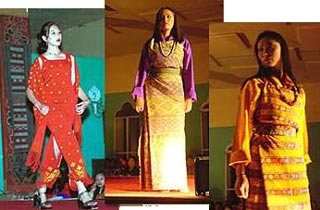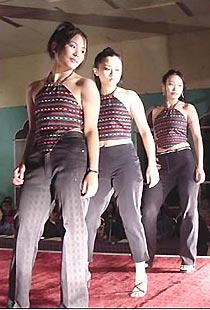|
Bhutan's
Textile Industry |
 |
Bhutan's
Economy: Textile Industry |
|
|
 |
|
Bhutan's
Textile Tradition
|
 |
 |
From
rigtht:
Winner
of the traditional design, a Mentse Marthra Shilochem style, silk on silk,
designed by Gaki Y. Dorji;
winner
of the pesar design, a new Ngosham style, silk on silk,
designed
by Karma Choki
winner
of the innovative style collection "Bhutanity"
designed
by Kencho Dema and Sonam Tshomo |
Not
long after the opening of the National Textile
Museum, on June 12 2002,
Bhutanese textiles have reached new heights as one of the most visible
traditional crafts and as a distinctly Bhutanese art form.A national design
competition packed the Thimphu sports complex hallas young Bhutanese men
and women modelled rich and finely woven clothing which one visitor interpreted
as the "living arts of Bhutan". Spectators saw the textiles as being "rich
and vibrant". And many saw them as representing the real "wealth" of Bhutan.
Painstakingly woven traditional garments with complex designs like the
mentse martha shilochem gho, and mentse martha methochem kira, both silk
and synthetically dyed, were displayed by models.
Participants
were also encouraged to come up with their own designs, called the pesar. Ghos and kiras in intricate designs, silk on silk, cotton on cotton, silk
on cotton, which were synthetically dyed were also displayed. Aside from
the traditional and the pesar designs, the participants came up with innovative
designs some of them western-influenced clothes but clearly Bhutanese.
Some
even displayed jeans, shirts, and trousers with Bhutanese patterns done
on the sleeves and legs. The entries were judged for their dyeing skill,
colour schemes, texture, complexity of the patterns, innovative patterns
designs, and creativity among others.
top
|
Fashion
awards
|

|
 |

Bhutan
is producing modern fashion too |
Gaki
Y. Dorji of Thimphu took the prize of Nu 50,000 for the best traditional
designs. Karma Chuki and, Kencho Dema and Sonam Tshomo took the same prize
amount for best pesar designs and best innovative designs. The second and
third prize in all the three category was Nu 30,000, and Nu 10,000. "I
was not aware that such assorted ghos and kiras existed in Bhutan. It was
an eye opener," said one Bhutanese spectator at the show.
Organized by
the National Commission For Cultural Affairs (NCCA) and the National Textile
Museum, the competition and the fashion show aimed to recognize and promote
the weavers of Bhutan. "Textiles are a rich and complex art form," said
the secretary of the NCCA, Dasho Sangay Wangchug. "Our best weavers have
a visually stunning mastery of colour, pattern and composition. They are
also skilled in using and combining various fibres like wild silk, nettle,
wool and yak hair from within the country, and cotton, domesticated silk,
metallic yarns and machine-spun cotton from India and China."
|
At a time
when Bhutanese are increasingly turning to cheaper factory-produced textiles
from outside, many felt that such an encouragement for traditional weavers
could not have been more appropriate
"This
will not only give our weavers a much needed boost and income but will
also refrain them from selling it to unscrupulous private collectors who
later brag about how they fooled the weavers for a few measly dollars more,"
said a concerned resident.
According
to Singye Dorji of the national textile museum, weaving had become a secondary
option in the villages because of the shortage of manpower. "Lured by urban
developments, many of the folks have gone, leaving just few at home to
farm," he said. In the past, weavers were employed by local nobility to
weave for the household, including exquisite garments for special occasions.
Others wove for barter and sale. "The weavers today are stressing quantity
rather than quality," Singye added. "They are inclined towards factory
made materials and simple designs to overcome the cost and time factor."
He pointed out that this could lead to the loss of intricate pattern designs,
natural dyes, and traditional raw materials.
Many
people fear that such practices would smother the tradition of the textile
arts being passed from mother to daughter. It was keeping such concerns
that led to the national design competition and fashion show to showcase
the products of Bhutanese weavers.
"The
royal government recognizes the need to preserve and promote this indigenous
knowledge base, to revive traditional skills, and to ensure that the creativity
and the innovativeness of the textile art form will be sustained" Dasho
Sangay Wangchug explained that weaving, or thazo, which was one of Bhutan's
13 traditional crafts, differed from the other 12 crafts in three ways.
It produced the largest volume, it involved the largest number of people
as producers, and it was the only craft dominated by women. "There were
many people who have already quoted in our auction brochures," said Singye
Dorji.
The cost of traditional and pesar garments ranged from Nu 7,000
to Nu 63,000. Some were not for sale. According to Singye Dorji, the proceeds
from the sale of tickets, costing Nu 500, Nu 300, Nu 100 and the sales
of garments, would go to the weavers, to promote the weavers of Khoma and Lhuentse, and also towards a museum fund. Most of the spectators expressed
their surprise at the high standard of weaving displayed. "The designs
were complex and fine and so painstakingly done that just watching the
clothes was sheer beauty," one young man told. Christel Dekena of Germany,
who was one of the judges, described the traditional and pesar dresses
as "exotic and pure art". The United Nations System in Bhutan, along with
the Swiss Development Co-operation, sponsored the national design competition
and the fashion show. Her Majesty Ashi Sangay Choden Wangchuck, patron
of the Textile Museum, was the chief guest.
| This
article was contributed by KUENSEL, Bhutan's National Newspaper 2002 |
 |
|



